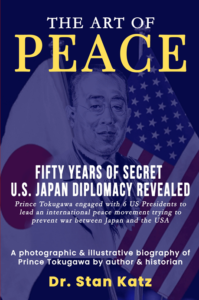Welcome to the intriguing world of one of America’s most significant military intelligence agents,
Colonel Sidney Mashbir
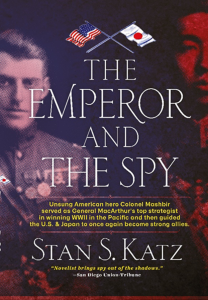
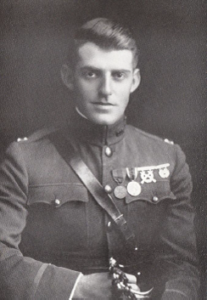
Wishing to be in the proximity of the man I had studied for many years, I stood over the tombstone of Colonel Sidney Forrester Mashbir, at Fort Rosecrans National Cemetery in San Diego, California. It was the acquisition of his personal library that first introduced me to this amazing patriotic hero.
Colonel Sidney Forrester Mashbir (1891–1973), spent the 1920s and 1930s in alliance with the Japanese Royal Family and other top leaders of Japan. Together, they made a valiant and heroic effort to maintain goodwill between their nation and prevent war. The Emperor and the Spy novel was inspired by the acquisition of Colonel Mashbir’s never-before-revealed intimate letters, secret official documents, medals, and photographs. It is a rare occasion when the personal papers of a spy come to light! For sixteen years these primary source materials, along with other historical archives were researched giving a window to an untold thrilling saga that presents a real-life American James Bond, who engaged in secret diplomacy and dangerous missions to shape world events and who pioneered the beginning of the CIA.
General Douglas MacArthur gave Mashbir the distinct honor of being the first American (non-prisoner of war) to again set foot in Japan as part of the peace keeping Occupation forces. To encourage a smooth transition for Japan to again become a strong ally with the U.S., Mashbir arranged for a Top Secret private meeting between General MacArthur and Emperor Hirohito. It was felt that the Emperor should not be blamed for the actions of militarists who had pushed Japan into the war. And as personal adviser to both General MacArthur and the Emperor, Mashbir shaped the positive rapport the U.S. and Japan would have during its Reconstruction/Occupation period, and far beyond . . .
The below photo was gifted to Colonel Mashbir by General Douglas MacArthur – The General’s inscription on that photo reveals how highly he regarded Mashbir’s contributions to winning WWII.
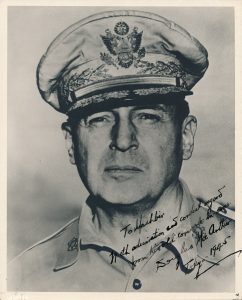
To Mashbir
With admiration and cordial regard from his old comrade-in-arms.
Douglas MacArthur
Tokyo – 1945
Based on Colonel Mashbir’s outstanding military contributions, General MacArthur five times nominated Mashbir to be promoted to Brigadier General. This promotion was also supported by General John Joseph Pershing, the Commander of all US Forces during WWI. Regrettably, the politics of post WWII prevented Mashbir receiving his deserved promotion to General.
Below are some aspects of Mashbir’s lengthily military intelligence career, where he often wore the hat of a diplomat:
Sidney Mashbir (1891 – 1973) was a first generation Jewish American, who grew up in Tucson, Arizona. At the age of thirteen, he joined the Arizona Guard as a bugle boy, during the time of the U.S. Cavalry. His military career continued through two World Wars!
- Mashbir’s early clandestine missions included stabilizing the U.S. / Mexico border during the Mexican Revolution – In 1914, Mashbir personally escorted the legendary bandit/revolutionary Pancho Villa to a peace conference with General John J. Pershing. When relations with Villa turned sour, Mashbir assisted General Pershing in chasing Villa.
- During the years leading up to and during World War I, Mashbir headed the U.S. Army’s Eastern Division of homeland security, eliminating enemy spy networks in the U.S.
- During the 1920s and 1930s, Mashbir formed a close friendship and alliance with many of Japan’s more progressive leaders – Together, they delayed and attempted to prevent war between their nations. One of Colonel Mashbir’s closest and most influential Japanese allies was Prince Iyesato Tokugawa (1863-1940), who for thirty years served as the President of Japan’s upper house of congress.
- Prince Tokugawa was heir to the powerful Shoguns who ruled feudal Japan for 265 years. His ancestor, Tokugawa Ieyasu, was the founder of that dynasty which began in the early 1600’s. The unification of Japan under Ieyasu is depicted in the popular novel Shogun by James Clavell…However, when that dynasty came to an end in 1868, Prince Iyesato Tokugawa instead devoted his life to diplomatically bridging Japan to the modern world.
- Mashbir so embraced the Japanese language and customs that he achieved a closer intimacy with the Japanese than almost any Westerner. Despite Mashbir and his Japanese allies’ courageous, peace-keeping efforts, World War II in the Pacific could not be stopped. At that tragic point, Mashbir’s brilliant military strategy skills were required to defeat Japan, a nation and people whom he had come to love.
- Colonel Mashbir described Prince Tokugawa as the true power behind the Imperial Throne and that Tokugawa was so politically powerful, that if he had not passed in 1940, Japan would not have joined the Axis Powers in WWII.
- Another of Mashbir’s significant Japanese allies was Baron Eiichi Shibusawa (1840–1931 ). Shibusawa was an international businessman, diplomat, and humanitarian. He is known as the “Father of Japan’s modern economy”. Prince Tokugawa and Baron Shibusawa were lifelong friends and compatriots who creatively strove to maintain amity between Japan and the West, and respectful relations within Asia. These great men guided Japan to prosper domestically. During their frequent visits to the US, they worked to improve the way Japanese Americans were treated in their new homeland, and the way Japanese Americans would come to see themselves.
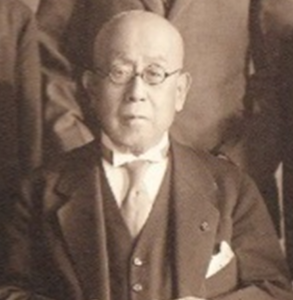
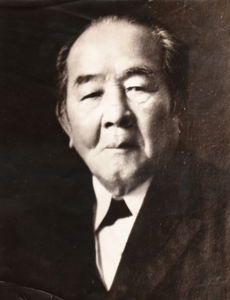
Prince Iyesato Tokugawa Baron Eiichi Shibusawa
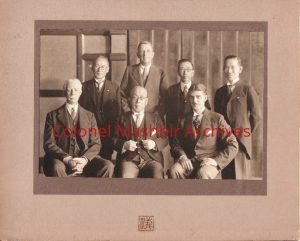
April, 1937, Tokyo: Group photo at the Imperial Hotel, Tokyo, following a Pan Pacific Club luncheon hosted by Prince Tokugawa to honor Colonel Sidney Mashbir’s return visit to Japan. Prince Tokugawa is seated adjacent to his friend and ally, Colonel Mashbir. Accompanying them are several of Prince Tokugawa’s other Japanese and American advisers. At that time, there was a rising militant movement in Japan. Mashbir was on a dangerous undercover mission. During Mashbir’s 1937 visit, Prince Tokugawa shared top secret Japanese intelligence information with Mashbir to bring back to the U.S. that might have preserved peace between their nations. However, their efforts were undermined. The novel The Emperor and the Spy highlights this untold story.
It is significant to mention that in 1934, Prince Tokugawa, as President of the Japan Red Cross Society promoted the creation of demilitarized “safe zones” in Chinese cities such as Shanghai, where tens of thousands of desperate Jewish European refugees could find safe haven from the expanding Nazi regime in Europe. These demilitarized “safe zones” continued throughout WWII and also served as a safe haven for hundreds of thousands of Chinese civilians. Prince Tokugawa has not yet be duly recognized for this significant humanitarian act. An application in Prince Tokugawa’s name is being submitted to Yad Vashem Holocaust Museum in Israel, to have Tokugawa be nominated as one of the Righteous Among the Nations. An honor for those who put their own lives at risk, while protecting the lives of Jews during the Holocaust.
Despite Mashbir and his Japanese allies their best efforts, WWII could not be stopped….Colonel Mashbir was then recruited by General Douglas MacArthur to command a top-secret intelligence organization ATIS (Allied Translator and Interpreter Section). ATIS would grow to almost 5,000 members, and significantly shaped the successful battle strategy in the Pacific, dramatically shortening the war. This organization was mainly composed of thousands of first generation Japanese Americans (Nisei) who patriotically volunteered to serve under Mashbir’s command. They translated and interpreted strategic military documents coming in from the Pacific battlefields, while also interrogating Japanese prisoners of war. Many members of ATIS also heroically went into battle to serve at the front lines.
Based on ATIS contributions, Colonel Mashbir particularly felt the injustice of Presidential Executive Order 9066 that resulted in the illegal imprisonment of countless loyal Japanese Americans. Who were held in detention camps following the attack at Pearl Harbor on Dec. 7th, 1941. Colonel Mashbir swore that once the war was over, he would devote himself to letting the world know of the major contributions made by patriotic Japanese Americans who had served under his command in ATIS.
As WWII was coming to a close, Colonel Mashbir then orchestrated the Japanese Surrender Signing Ceremony which officially brought the conflict to an end, avoiding a major destructive conflict on mainland Japan, had the war continued.
As a pioneer of modern intelligence, in 1942, Mashbir was one of the two men who prepared the first draft implementing directives for the creation of the future Central Intelligence Agency (CIA).
In 1988, fifteen years after Colonel Mashbir’s death, he was inducted into the Army’s Military Intelligence Corps Hall of Fame for his major contributions to our nation’s security. Below is the honorary certificate that was given to his family.
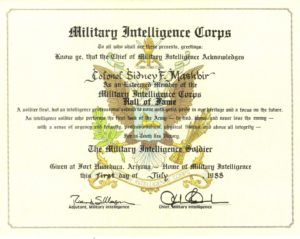
Colonel Mashbir has as is to be expected of talented spies, largely remained in the shadows of history, until now.
The Emperor and the Spy reveals the colorful life of this heroic individual. The novel strongly depicts actual events, but has been novelized to recognize its potential as an epic cinematic experience. It is thrill packed with action, suspense, humor, romance, and lots of historical surprises.

Available in PRINT, EBOOK, and as an AUDIOBOOK
The Emperor and the Spy was followed by the illustrated biography: THE ART OF PEACE
This book honors Prince Tokugawa and his Japanese and non-Japanese allies. It is a non-fictional sequel to The Emperor and the Spy. The Art of Peace presents hundreds of fascinating illustrations, many rare and one-of-a-kind, offering an intriguing new perspective on U.S. Japan relations and world history.
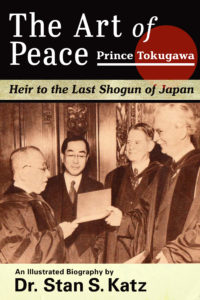
THE ART OF PEACE (expanded edition) is available as an EBook
DESCRIPTION OF BOOK COVER PHOTO:
After WWII ended, there was an urgent diplomatic agenda put in place to leave behind the details of the period leading to that tragic conflict. The goal was to expediently reestablish Japan and the U.S. as friends and political allies. This resulted in the prior decades to that war being lost, forgotten, or even destroyed – For instance, the ABOVE book cover photo comes from what might well be the last remaining crumbling copy of a 1934 Japanese magazine. It presents Prince Tokugawa receiving an Honorary Doctor of Laws Degree from the University of Southern California. The president of the university Dr. Rufus B. von Kleinsmid hands the certificate to Prince Tokugawa. (Left to right in photo: Prince Iyesato Tokugawa; Iyemasa Tokugawa; George I. Cochran; Dr. Rufus B. von Kleinsmid.)
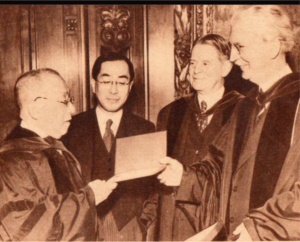
This presentation took place during a special luncheon given March 19, 1934 in Los Angeles, hosted by George I. Cochran, the president of the school’s Board of Trustees. Prince Iyesato Tokugawa was accompanied by his son Iyemasa, the newly appointed Japanese Minister to Canada.
The Los Angeles Times stated that this honorary degree was given to Prince Tokugawa “in recognition of distinguished service in international statesmanship,” and for his “support of many philanthropic and educational movements.”
In accepting the honor, Tokugawa respectfully responded, “He wished to receive it in the name of the Japanese people as a whole rather than as a personal distinction.” The Los Angeles Times stated that a banquet dinner was to be hosted by the Japan-America Society of Los Angeles to honor Prince Tokugawa’s visit. The Governor of California and the former Mayor of Los Angeles planned to attend.
Surprisingly, despite this great recognition given to Prince Tokugawa, the University of Southern California has no record of this event having taken place. During the following year, 1935, President Franklin D. Roosevelt was also awarded an Honorary Doctor of Laws Degree from USC. Prince Tokugawa and President FDR knew each other well. During Tokugawa’s 1934 visit to the U.S. the two men met and discussed ways in which they could maintain amity between their nations. Prince Tokugawa even invited FDR to visit Japan with hopes that a face to face meeting with Japanese leadership might lead to a better understanding of international events in that region.
The ART OF PEACE has been been republished with the title: THE ART OF DIPLOMACY. This new title represents the diverse political, diplomatic, and humanitarian accomplishments of Prince Tokugawa and his allies.
Note: THE ART OF PEACE has an additional 100 pages of historical/Bibliographic notes to assist researchers.
THE ART OF DIPLOMACY is available in PRINT and KINDLE EBook Edition
Below is a link to BOOK REVIEWS for the above books:
https://theemperorandthespy.com/reviews/
A portion of book sales will go to these charities:
- American Veterans’ organizations in honor of Colonel Mashbir.
- Social service groups Colonel Mashbir was once active in, such as Rotary International.
- Japanese Red Cross Society, to show respect for the Japanese leaders Colonel Mashbir allied with in the pursuit of peace.



